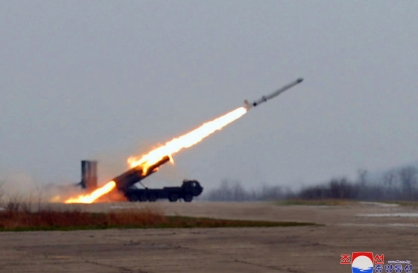Government to double state support for rain-battered areas
Extra budget off the table for now as monsoon season set to continue
By Ko Jun-taePublished : Aug. 12, 2020 - 15:02

The government is doubling its subsidies for disaster relief and repair efforts as the country faces a record-long monsoon season that has caused significant casualties and property damage.
The decision was made during a meeting involving the Cabinet, the ruling Democratic Party of Korea and the Blue House at the National Assembly on Wednesday morning.
“We came to a consensus that national-level support is needed for regions affected by the unprecedented rainfall and discussed the need for quick repair efforts and preventive measures,” said party spokesperson Kang Hoon-sik during a press briefing.
“The government has also decided to relieve the financial burden on municipalities with a weak fiscal capacity from responding to the COVID-19 outbreak and to realize disaster relief for those who have died or gone missing.”
At the meeting, the government decided to double its support for families of the deceased to 20 million won ($16,856) from the 10 million won specified in the Disaster Relief Act. Victims of flood-related property damage will receive 2 million won, double the usual amount. The amounts have remained unchanged since the act was introduced in 1995.
The government has fiscal room to roll out the increased support, participants at the meeting agreed, deferring any discussion on a supplementary budget to a later time if and when necessary.
Ruling party chief Lee Hae-chan had previously raised the possibility of an extra budget, which would be the fourth this year, but Finance Minister Hong Nam-ki publicly voiced his opposition.
The government estimates that around 500 billion won is needed for the recovery efforts, Kang said, and the central government can cover this with its 3 trillion won disaster countermeasures budget. In addition, the provincial governments’ 2.4 trillion won disaster budgets will contribute to local relief efforts.
“The government has decided to minimize the administrative procedures to declare additional special disaster zones while directly and indirectly providing support for the regions,” the spokesperson added.
Authorities on Friday designated seven hard-hit areas as special disaster zones, allowing them to receive state aid and other support. Officials are reviewing requests from other affected districts and municipalities for the same designation.
The decision to provide additional state support comes as South Korea is experiencing its longest-ever monsoon season, which experts attribute to climate change. Wednesday marked the 50th day of the summer monsoon season, breaking the record for the country’s longest rainy season since data has been recorded.
The previous record was set in 2013, when the monsoon season continued for 49 days. The Korea Meteorological Administration expects this year’s rainy season, which started June 24, to continue until Sunday.
Jeju Island’s monsoon season finally ended July 28 after 49 days, breaking the island’s record of 47 days set in 1998.
According to the Central Disaster and Safety Countermeasure Headquarters at 6 a.m. Wednesday, the torrential rains that started Aug. 1 have displaced more than 7,800 people from their homes, affecting 4,498 households. Of those who were displaced, 3,015 are still staying in nearby gymnasiums and community centers.
A total of 24,203 incidents of property damage have been reported, with 14,271 of them concerning private property. Around 27,744 hectares of farmland have been inundated, while 5,926 residential buildings have been damaged or flooded.
Repairs are around 60.6 percent complete, involving 14,788 of the reported cases. Recovery efforts are expected to proceed faster as the rain has slowed down in most regions.
The heavy rain also forced authorities to close 63 roads, as well as 612 trekking routes at 22 national parks. Train services remained disrupted on five routes.
Since Aug. 1, the country has reported 33 dead, nine missing and eight injured as a result of the rain. The death count rose by two as officials located the bodies of missing people from Damyang, South Jeolla Province, and Eumseong, North Chungcheong Province.
The death counts do not include casualties from a boat accident near Uiam Dam in Chuncheon, Gangwon Province, as the case is categorized as a marine accident. Of the eight people who were swept underwater after three boats capsized, two were rescued, four were found dead and two others are still missing.
Authorities are bracing for more damage as the national weather agency expects the nationwide downpour to resume Thursday. The downpour is likely to be concentrated from Friday to Sunday in the capital, Seoul, and in Gyeonggi, Gangwon, North Chungcheong and South Chungcheong provinces.
By Ko Jun-tae (ko.juntae@heraldcorp.com)
The decision was made during a meeting involving the Cabinet, the ruling Democratic Party of Korea and the Blue House at the National Assembly on Wednesday morning.
“We came to a consensus that national-level support is needed for regions affected by the unprecedented rainfall and discussed the need for quick repair efforts and preventive measures,” said party spokesperson Kang Hoon-sik during a press briefing.
“The government has also decided to relieve the financial burden on municipalities with a weak fiscal capacity from responding to the COVID-19 outbreak and to realize disaster relief for those who have died or gone missing.”
At the meeting, the government decided to double its support for families of the deceased to 20 million won ($16,856) from the 10 million won specified in the Disaster Relief Act. Victims of flood-related property damage will receive 2 million won, double the usual amount. The amounts have remained unchanged since the act was introduced in 1995.
The government has fiscal room to roll out the increased support, participants at the meeting agreed, deferring any discussion on a supplementary budget to a later time if and when necessary.
Ruling party chief Lee Hae-chan had previously raised the possibility of an extra budget, which would be the fourth this year, but Finance Minister Hong Nam-ki publicly voiced his opposition.
The government estimates that around 500 billion won is needed for the recovery efforts, Kang said, and the central government can cover this with its 3 trillion won disaster countermeasures budget. In addition, the provincial governments’ 2.4 trillion won disaster budgets will contribute to local relief efforts.
“The government has decided to minimize the administrative procedures to declare additional special disaster zones while directly and indirectly providing support for the regions,” the spokesperson added.
Authorities on Friday designated seven hard-hit areas as special disaster zones, allowing them to receive state aid and other support. Officials are reviewing requests from other affected districts and municipalities for the same designation.
The decision to provide additional state support comes as South Korea is experiencing its longest-ever monsoon season, which experts attribute to climate change. Wednesday marked the 50th day of the summer monsoon season, breaking the record for the country’s longest rainy season since data has been recorded.
The previous record was set in 2013, when the monsoon season continued for 49 days. The Korea Meteorological Administration expects this year’s rainy season, which started June 24, to continue until Sunday.
Jeju Island’s monsoon season finally ended July 28 after 49 days, breaking the island’s record of 47 days set in 1998.
According to the Central Disaster and Safety Countermeasure Headquarters at 6 a.m. Wednesday, the torrential rains that started Aug. 1 have displaced more than 7,800 people from their homes, affecting 4,498 households. Of those who were displaced, 3,015 are still staying in nearby gymnasiums and community centers.
A total of 24,203 incidents of property damage have been reported, with 14,271 of them concerning private property. Around 27,744 hectares of farmland have been inundated, while 5,926 residential buildings have been damaged or flooded.
Repairs are around 60.6 percent complete, involving 14,788 of the reported cases. Recovery efforts are expected to proceed faster as the rain has slowed down in most regions.
The heavy rain also forced authorities to close 63 roads, as well as 612 trekking routes at 22 national parks. Train services remained disrupted on five routes.
Since Aug. 1, the country has reported 33 dead, nine missing and eight injured as a result of the rain. The death count rose by two as officials located the bodies of missing people from Damyang, South Jeolla Province, and Eumseong, North Chungcheong Province.
The death counts do not include casualties from a boat accident near Uiam Dam in Chuncheon, Gangwon Province, as the case is categorized as a marine accident. Of the eight people who were swept underwater after three boats capsized, two were rescued, four were found dead and two others are still missing.
Authorities are bracing for more damage as the national weather agency expects the nationwide downpour to resume Thursday. The downpour is likely to be concentrated from Friday to Sunday in the capital, Seoul, and in Gyeonggi, Gangwon, North Chungcheong and South Chungcheong provinces.
By Ko Jun-tae (ko.juntae@heraldcorp.com)


![[Exclusive] Korean military set to ban iPhones over 'security' concerns](http://res.heraldm.com/phpwas/restmb_idxmake.php?idx=644&simg=/content/image/2024/04/23/20240423050599_0.jpg&u=20240423183955)

![[Graphic News] 77% of young Koreans still financially dependent](http://res.heraldm.com/phpwas/restmb_idxmake.php?idx=644&simg=/content/image/2024/04/22/20240422050762_0.gif&u=)




![[Pressure points] Leggings in public: Fashion statement or social faux pas?](http://res.heraldm.com/phpwas/restmb_idxmake.php?idx=644&simg=/content/image/2024/04/23/20240423050669_0.jpg&u=)








